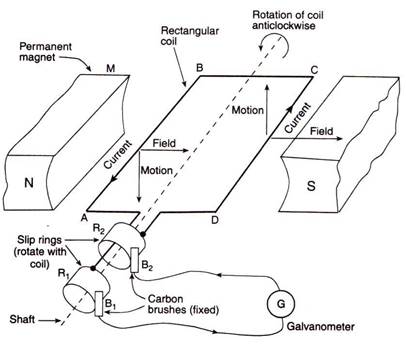Draw the labelled diagram of an A.C. generator. With the help of this diagram, explain the construction and working of an A.C. generator.

Construction:
AC generator consists of a rectangular coil ABCD which can be rotated fastly between the poles N and S of a strong horseshoe-type permanent magnet M. The coil is made of a large number of turns of insulated copper wire. The two ends A and D of the coil are connected to two circular pieces of copper metal called slip rings R1 and R2. As the slip rings rotate with the coil, the two fixed pieces of carbon called brushes, B1 and B2, keep contact with them. So, the current produced in the rotating coil can be tapped out through slip rings into the carbon brushes. The outer ends of carbon brushes are connected to a galvanometer to show the flow of current in the external circuit.
Working:
Let us assume the coil ABCD, which is at the start in the horizontal position, is rotated in the anticlockwise direction. The side AB of the coil moves down and side CD moves up. By virtue of this, induced current is produced in both the sides, which flows in the direction BADC (according to Fleming's right hand rule). Thus, in the first half rotation, the current in the external circuit flows from brush B1 to B2. After half revolution, sides AB and CD will interchange their positions. So, side AB starts moving up and side CD starts moving down. As a result, direction of induced current in the coil is reversed and flows in the direction CDAB. The current in the external circuit flows from brush B2 to B1.